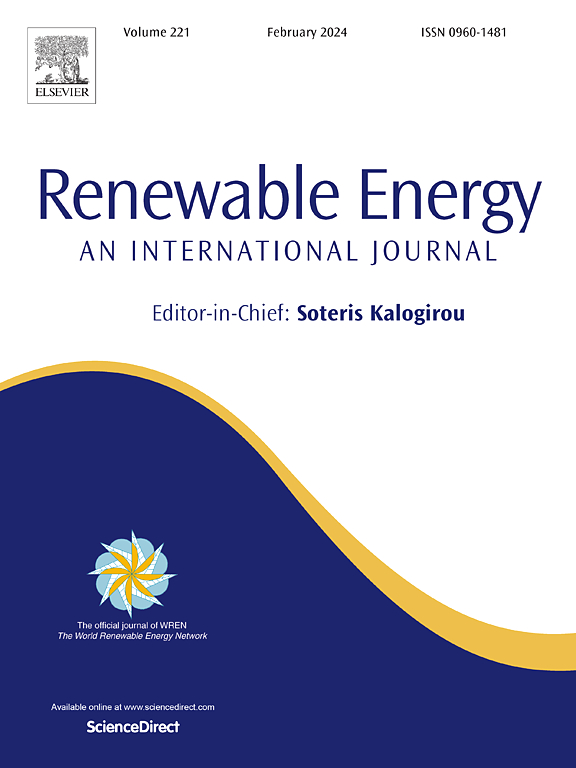Advancing sensible heat storage: A novel transient heat transfer model for concrete-based TES modules for CSP applications
IF 9.1
1区 工程技术
Q1 ENERGY & FUELS
引用次数: 0
Abstract
Concentrating solar power (CSP) plays a crucial role in renewable energy systems, offering high-temperature heat for electricity generation and industrial processes while supporting the transition to sustainable energy. Thermal energy storage (TES) improves the reliability and dispatchability of CSP systems. Among the sensible heat storage options, concrete emerges as a cost-effective and eco-friendly alternative that warrants further investigation. This study introduces a comprehensive mathematical model for simulating the transient thermal behaviour of concrete-based TES modules. The model accommodates diverse geometries, supports a wide range of heat transfer fluids (HTFs) in all flow regimes, and accounts for heat losses to the environment, factors that are often overlooked in prior research. The mathematical framework was incorporated into a software platform called OpenModelica and will later be included in a tool developed by the authors to evaluate the performance of CSP plants. Before this integration takes place, the model undergoes validation, which is the primary focus of this study. The model was validated through two case studies, one theoretical and the other experimental, each involving different operational conditions, geometries, HTFs, and materials. The theoretical case confirmed that the model could capture the key physical phenomena governing transient heat transfer in the storage module. A comparison between the simulation results and experimental data revealed a strong agreement in temperature, heat flow, and total energy transmitted, with temperature errors within the IEC 60751 standard and total energy transfer errors ranging from −6.15 % to +5.69 %. These findings highlight the potential of concrete-based TES to enhance the performance of CSP systems, contributing to reliable and sustainable energy solutions.
推进显热储存:用于CSP应用的基于混凝土的TES模块的新型瞬态传热模型
聚光太阳能(CSP)在可再生能源系统中发挥着至关重要的作用,为发电和工业过程提供高温热量,同时支持向可持续能源的过渡。热储能技术提高了光热发电系统的可靠性和可调度性。在显热存储选项中,混凝土作为一种具有成本效益和环保的替代方案出现,值得进一步研究。本研究引入了一个综合的数学模型来模拟基于混凝土的TES模块的瞬态热行为。该模型可适应不同的几何形状,支持各种流动状态下的广泛传热流体(HTFs),并考虑了在之前的研究中经常被忽视的环境热损失因素。数学框架被整合到一个名为OpenModelica的软件平台中,随后将被包含在作者开发的一个工具中,用于评估CSP发电厂的性能。在此整合发生之前,模型进行验证,这是本研究的主要焦点。该模型通过两个案例研究进行了验证,一个是理论研究,另一个是实验研究,每个案例都涉及不同的操作条件、几何形状、HTFs和材料。理论算例证实,该模型能够捕捉到控制储热模块中瞬态传热的关键物理现象。模拟结果与实验数据的比较表明,在温度、热流和总传递能量方面,温度误差符合IEC 60751标准,总传递能量误差在−6.15% ~ + 5.69%之间。这些发现突出了基于混凝土的TES在提高CSP系统性能方面的潜力,有助于提供可靠和可持续的能源解决方案。
本文章由计算机程序翻译,如有差异,请以英文原文为准。
求助全文
约1分钟内获得全文
求助全文
来源期刊

Renewable Energy
工程技术-能源与燃料
CiteScore
18.40
自引率
9.20%
发文量
1955
审稿时长
6.6 months
期刊介绍:
Renewable Energy journal is dedicated to advancing knowledge and disseminating insights on various topics and technologies within renewable energy systems and components. Our mission is to support researchers, engineers, economists, manufacturers, NGOs, associations, and societies in staying updated on new developments in their respective fields and applying alternative energy solutions to current practices.
As an international, multidisciplinary journal in renewable energy engineering and research, we strive to be a premier peer-reviewed platform and a trusted source of original research and reviews in the field of renewable energy. Join us in our endeavor to drive innovation and progress in sustainable energy solutions.
 求助内容:
求助内容: 应助结果提醒方式:
应助结果提醒方式:


